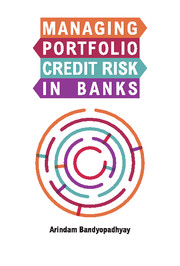Book contents
- Frontmatter
- Dedication
- Contents
- Tables, Figures, Charts
- Preface
- Acknowledgements
- Abbreviations
- 1 Introduction to Credit Risk
- 2 Credit Rating Models
- 3 Approaches for Measuring Probability of Default (PD)
- 4 Exposure at Default (EAD) and Loss Given Default (LGD)
- 5 Validation and Stress Testing of Credit Risk Models
- 6 Portfolio Assessment of Credit Risk: Default Correlation, Asset Correlation and Loss Estimation
- 7 Economic Capital and RAROC
- 8 Basel II IRB Approach of Measuring Credit Risk Regulatory Capital
- Index
7 - Economic Capital and RAROC
Published online by Cambridge University Press: 05 May 2016
- Frontmatter
- Dedication
- Contents
- Tables, Figures, Charts
- Preface
- Acknowledgements
- Abbreviations
- 1 Introduction to Credit Risk
- 2 Credit Rating Models
- 3 Approaches for Measuring Probability of Default (PD)
- 4 Exposure at Default (EAD) and Loss Given Default (LGD)
- 5 Validation and Stress Testing of Credit Risk Models
- 6 Portfolio Assessment of Credit Risk: Default Correlation, Asset Correlation and Loss Estimation
- 7 Economic Capital and RAROC
- 8 Basel II IRB Approach of Measuring Credit Risk Regulatory Capital
- Index
Summary
Banks ultimately need to assess the cushion that protects them against various business risks, which is economic capital. The process by which a bank assigns economic capital to transactions, products, customers and business lines is known as risk-based capital allocation. In order to maximize shareholder value, business strategies in banks should be based on risk-based capital allocation and performance incentives. Risk-adjusted return on capital (RAROC) and economic capital (EC) are two powerful risk management tools that assist banks and financial institutions (FIs) in both measuring solvency and evaluating performance of different business activities.
EC is the amount of capital needed to provide a cushion against the unexpected loss incurred in the credit portfolio. It checks whether a bank's available capital equals or exceeds the capital necessary to ensure survival with a given level of confidence. While regulatory capital focuses on satisfying the objectives of the regulator, economic capital looks at internal management of the business to maximize the shareholder return. The amount of EC depends on the bank's target debt rating in the market. To achieve the proper capitalization for any line of business, it is necessary for the bank to identify a confidence level that is consistent with the bank's desired credit rating. This is because a desired debt rating for the bank corresponds to a given probability of capital exhaustion. Credit value at risk method (C-VaR) is considered worldwide as a standard approach to estimate risk capital. Economic capital is the difference between this worst-case loss and the expected loss. It is the estimate of the level of capital that a bank requires to operate its business with a desired target solvency level.
In financial mathematics, value at risk (VaR) is a widely used measure of the risk of loss on a specific portfolio of financial assets. VaR summarizes in a single number the downside risk of an institution, under normal conditions, from borrower risk movements. By definition, VaR is maximum loss over a target horizon such that there is a low, pre-specified probability that the actual loss will be larger.
Credit VaR and EC
EC is typically defined as the difference between some given percentile of a loss distribution and the expected loss. It is sometimes referred to as the unexpected loss at the confidence level. It is measured through the value at risk metric.
- Type
- Chapter
- Information
- Managing Portfolio Credit Risk in Banks , pp. 276 - 317Publisher: Cambridge University PressPrint publication year: 2016



